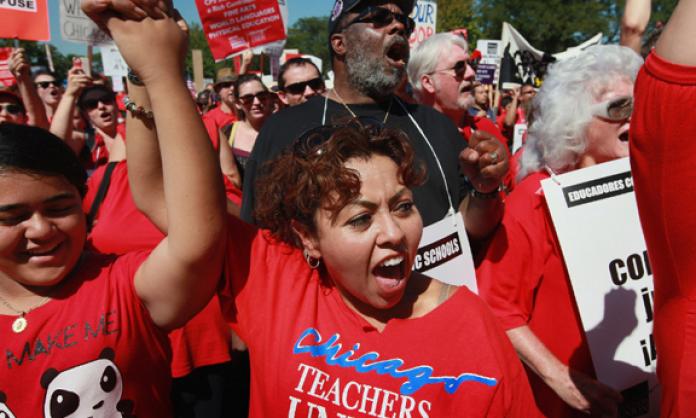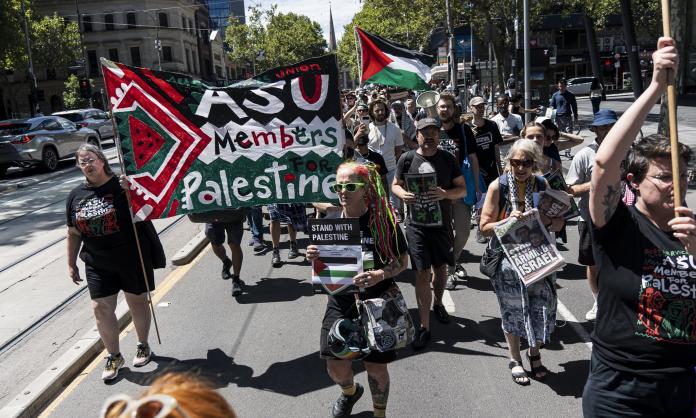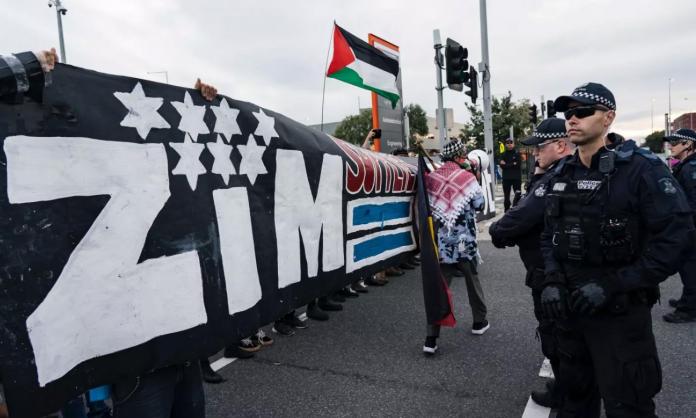Amid the waves of protest sweeping the United States, we get a glimpse of the incredible power that organised workers can bring to a mass movement.
On 20 January, the day of Donald Trump’s inauguration, unionised dock workers shut down the massive port of Oakland, California, one of the busiest container ports in the US. As Trump’s pitiful inauguration crowd gathered in Washington, members of Local 10 (Oakland branch) of the International Longshore and Warehouse Union stayed away from work – paralysing the port in a dramatic example of the power of workers to bring business as usual to a grinding halt.
The protest stoppage at Oakland didn’t come out of nowhere. Local 10 represents a militant multi-racial workforce that carries some of the very best of the radical traditions of the US working class. The Oakland waterfront is one of the few places where radical politics and working class organisation survived through to today against the incredible pressures of the McCarthyite witch-hunts of the 1950s, which did so much to smash radical political traditions in US unions. Members of Local 10 have used their enormous industrial power in support of the struggle against apartheid in South Africa in the 1980s, in protest strikes against US wars and police killings and – along with massive community protests – to shut down the Oakland waterfront during the Occupy protests of 2011.
Local 10 is not the only group of unionised workers to stop work in protest at the vicious, anti-working class agenda of the Trump administration.
Just over a week after Local 10 set the pace, another group of workers with a militant tradition also took strike action to help paralyse key infrastructure. On the evening of 28 January, as thousands of protesters around the US clogged airports in protest against an executive order banning refugees and travellers from seven Muslim-majority countries, the New York Taxi Workers Alliance called on its 19,000 members to contribute to the protest by stopping services to New York’s JFK Airport.
When Uber attempted to scab on the one-hour strike by dropping “surge” pricing, up to 200,000 Uber users responded by deleting their Uber account and popularising the hashtag #DeleteUber. A follow-up protest at Uber’s New York headquarters prompted Uber chief executive Travis Kalanick to resign from Donald Trump’s business advisory board. This result shows the potential for worker actions – even quite small ones – to be the centre of mobilisations that disrupt Trump’s agenda.
Again, this protest action didn’t come from nowhere. The New York Taxi Workers Association burst on to the scene with a series of dramatic strikes in 1998. Then New York mayor Rudi Giuliani – who today is a prominent businessman and vocal Trump supporter – responded to the taxi strikes by denouncing the NYTWA as “taxi terrorists” and deploying police in armoured cars to intimidate strikers.
Nevertheless, the NYTWA – whose members are 94 percent immigrant, who are not classed as employees, and who therefore, according to US law, can’t even form a union and win the protections that that entails – won concessions including a pay rise, and have continued to organise drivers in New York City and beyond. The NYTWA protest strike inspired similar stoppages by taxi workers in Philadelphia, Austin, Houston, and San Francisco.
As NYTWA leader Bhairavi Desai explained, usually strikes are seen as the end point of a long campaign, but the rupture of a Trump presidency creates a new situation. Usually, “You work on a campaign and there will be many months, if not years, of build-up before you go to strike vote. It is seen as the final action. It is a moment of urgency. Well, that is what millions of people are waking up to every single day under this presidency. There is a moment of urgency”.
That same urgency has been felt by workers in one of the key, non-union industries in the US – the giant tech firms of Silicon Valley. Even before Trump was sworn in as president, a group of tech workers circulated an open letter under the banner of neveragain.tech. Recalling IBM’s profitable collaboration with the organisers of the Holocaust, letter signatories pledged not to build Trump’s promised Muslim registry, or “to facilitate the mass deportation of people the government believes to be undesirable”. Within a few days, more than 2,800 tech workers had signed on.
Following through on this pledge will be hampered by the lack of union organisation in Silicon Valley. Despite the enormous potential industrial power of tech workers, the companies remain a bastion on non-unionism. However, workers at Comcast and Google walked out in their hundreds and their thousands (with the approval of management) in protest at Trump’s travel ban targeting Muslims. The ginger group Tech Solidarity has reportedly been getting more than 100 workers to its meetings. The political turmoil among tech workers has sparked organising efforts at blue chip tech companies including IBM and Oracle, which have not come out against Trump, and protests at companies such as Palantir, which stands to gain handsomely from work on repressive technologies for the Trump administration.
The efforts of tech workers to organise in their workplaces, often for the first time, and the short but powerful strikes of taxi workers and dock workers, send a signal of what is possible on a much larger scale if more unions and workers decide to turn opposition to Trump into industrial action.
The downside
There is another side to the response of US unions to the Trump presidency. The US ruling class has historically used a colossal level of corruption and gangsterism to foster compliant unions – a style of union leadership that depends on wheeling and dealing in political and financial favours, rather than organising the unorganised.
Exhibit “A” for this sort of unionism has often been the top leaders of various building trades unions, who tend to rely on favours from local political machines rather than industrial power to maintain high wages (and, often, something of a “jobs trust” for their majority white membership).
So it was a shock, but no great surprise, to see a collection of construction trades union leaders sitting down with Trump in the Oval Office on the president’s first full working day. Carpenters Union leader Doug McCarron set the tone when he declared that Trump’s inauguration address was “a great moment for working men and women in the United States”.
With Trump having used the construction union leaders as blue collar union decoration for his profoundly anti-working class agenda, there are now indications that he is happy enough to throw them and their members under a bus. Some of his key appointments indicate moves to scrap the “prevailing rates” legislation that props up construction wages on federal government projects.
Outside of the construction trades, the most prominent US union leader to lavish public praise on Trump is James P. Hoffa, head of the Teamsters Union, which covers truck drivers and warehouse workers. James P. is the son of Jimmy Hoffa – perhaps the most famous gangster-aligned union boss. Hoffa has only just survived a powerful rank and file challenge from workers sick of concessions to major employers.
It’s much easier for a union leader in this position to blame international competition for workers’ deteriorating conditions, rather than his own failure to lead a fight. Hoffa was true to form, singing Trump’s praises for scrapping the Trans-Pacific Partnership. (In fact, this awful pro-corporate trade deal was dead in the water already, with Trump just performing the last rites.)
According to much of the media, and Trump’s own myth making, it is the former manufacturing heartlands of the US that propelled him into office. This is massively overstated. There were certainly some tens of thousands of former Obama voters in key “rust belt” states that swung the election Trump’s way, but this was far from any Trump landslide.
Much more of a factor was that candidate Clinton pointedly failed to promise anything to blue collar workers – so millions stayed away from the polls. In the manufacturing centres, it’s not hard to find unionists who see through Trump’s promise of more blue collar jobs as a “horse and pony show”, while it will take time for other workers to realise that president Trump is not coming to save them.
Potential
For many other groups of workers, however, there can be no ambiguity – the Trump agenda represents a frontal attack on everything they hold dear. This is certainly true of teachers, who make up one-quarter of the unionised workforce in the US. After years of sustained attacks under Obama, public education now faces total dismemberment from billionaire education “reformer” Betsy DeVos.
Many teacher unions start this crucial battle from a long way back, having spent years avoiding a fight in favour of a strategy of compromise and retreat. However, some – most notably the Chicago Teachers Union – have shown that a principled stand for well-funded public education, backed with a serious approach to organising and a commitment to industrial action, can transform the political debate around education and pull many others into a serious fight.
Trump’s vicious attack on Hispanic communities, with many long term residents being targeted for immediate deportation, also has the potential to shake up US unions. One of the biggest strikes and demonstrations in US history was the “day without an immigrant” strike on 1 May 2006, the culmination of months of protests and strikes against moves to criminalise undocumented immigrants in the US. This enormous show of force killed the anti-immigrant legislation stone dead. It also pushed along serious organising efforts in some workplaces.
A call for another “day without an immigrant” on 16 February this year, circulated on social media and with little formal backing from organisations in Hispanic communities, shuttered many shops and led to high school walkouts and street protests in many cities and towns. Some Hispanic organisations are orienting seriously towards major strikes and protests on 1 May and beyond.
The stakes are enormous. The response of organised workers will play a major role in determining whether Trump crashes through, or crashes.
And as always, which course the labour movement takes will be a matter of fierce political contest. On the one hand are those who want to follow the example of Local 10 and the New York Taxi Workers Association, who want to turn the decent instincts of tech workers and others across the country into an organised political and industrial force. On the other hand are those who, like the construction trade union leaders, see their role as cheerleaders for this government by and for the billionaires.
Decades of defeat and retreat in most of the US union movement mean that forces advocating an approach of class struggle are starting from a long way back. But with politics in turmoil, and waves of sustained mass protest rolling across the country, there is a real opportunity to start turning the tide.











